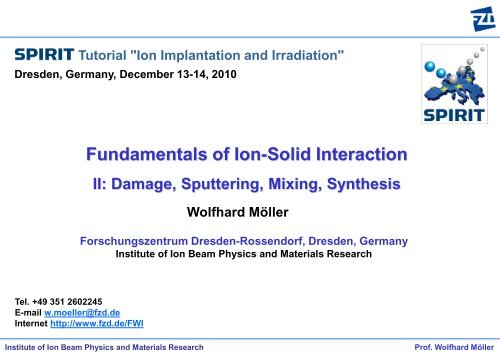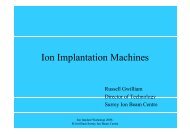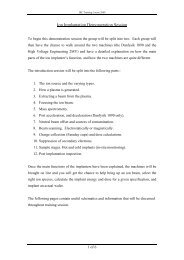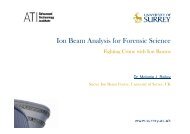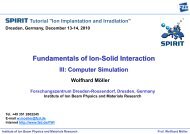Fundamentals of Ion-Solid Interaction - SPIRIT
Fundamentals of Ion-Solid Interaction - SPIRIT
Fundamentals of Ion-Solid Interaction - SPIRIT
Create successful ePaper yourself
Turn your PDF publications into a flip-book with our unique Google optimized e-Paper software.
Tutorial "<strong>Ion</strong> Implantation and Irradiation"<br />
Dresden, Germany, December 13-14, 2010<br />
Tel. +49 351 2602245<br />
E-mail w.moeller@fzd.de<br />
Internet http://www.fzd.de/FWI<br />
<strong>Fundamentals</strong> <strong>of</strong> <strong>Ion</strong>-<strong>Solid</strong> <strong>Interaction</strong><br />
II: Damage, Sputtering, Mixing, Synthesis<br />
Wolfhard Möller<br />
Forschungszentrum Dresden-Rossendorf, Dresden, Germany<br />
Institute <strong>of</strong> <strong>Ion</strong> Beam Physics and Materials Research<br />
Institute <strong>of</strong> <strong>Ion</strong> Beam Physics and Materials Research Pr<strong>of</strong>. Wolfhard Möller
Effects <strong>of</strong> Collision Cascade<br />
Sputtering<br />
Surface<br />
Erosion<br />
<strong>Ion</strong><br />
Scattering<br />
Atomic Displacement<br />
Radiation Damage<br />
Atomic Mixing<br />
Recoil Implantation<br />
<strong>Ion</strong><br />
Implantation<br />
TRIM Binary Collision Computer Simulation<br />
<strong>Ion</strong> Trajectories<br />
100 incident ions<br />
Recoil Distribution<br />
1000 incident ions<br />
1 keV<br />
Ar + Si<br />
0 Depth (nm) 10<br />
Institute <strong>of</strong> <strong>Ion</strong> Beam Physics and Materials Research Pr<strong>of</strong>. Wolfhard Möller
Cascade Regimes<br />
Linear Cascade Thermal Spike<br />
Low energy density<br />
No interaction between moving particles<br />
Sequence <strong>of</strong> binary collisions<br />
High energy density<br />
<strong>Interaction</strong> between moving particles<br />
Many-body interactions<br />
Thermal spike regime may be entered in the early phase<br />
<strong>of</strong> the cascade at sufficiently high energy density<br />
(e.g., heavy ion incidence at energy ~100 keV)<br />
Thermal spike regime is always entered in the<br />
thermalization phase <strong>of</strong> the cascade<br />
(at mean energies <strong>of</strong> the cascade atoms lower than solid-state<br />
binding energies - typically a few eV)<br />
Institute <strong>of</strong> <strong>Ion</strong> Beam Physics and Materials Research Pr<strong>of</strong>. Wolfhard Möller
Spatial Structure <strong>of</strong> Cascades<br />
E 0<br />
Light ions, high energies Heavy ions, low energies<br />
T<br />
T Nuclear Energy Transfer<br />
E 0<br />
T<br />
Spatial deposition <strong>of</strong> energy in cascade is <strong>of</strong>ten described by a Gaussian rotational ellipsoid<br />
E 0<br />
R D<br />
x,y<br />
z<br />
E0 <br />
3 2 2 <br />
z - R <br />
2 2 2<br />
D x y<br />
Dr <br />
exp -<br />
2<br />
2<br />
2 z 2 <br />
z x<br />
x<br />
<br />
<br />
<br />
<br />
<br />
<br />
<br />
<br />
<br />
F 2<br />
(E 0) total energy deposited into nuclear collisions<br />
R D mean depth <strong>of</strong> nuclear energy deposition<br />
(exact values for R D, x and z best from collisional<br />
computer simulation)<br />
Similar average topology<br />
for multiple ion incidence<br />
Institute <strong>of</strong> <strong>Ion</strong> Beam Physics and Materials Research Pr<strong>of</strong>. Wolfhard Möller
Collisional Damage<br />
F<br />
T <br />
N <br />
T<br />
2U<br />
Cascade atom receives<br />
sufficient energy to<br />
become displaced<br />
Analytical hard-sphere approximation for number <strong>of</strong><br />
resulting I-V pairs (or Frenkel pairs) (Kinchin and Pease)<br />
d<br />
T initial energy <strong>of</strong> recoil atom<br />
U d damage threshold energy<br />
(15 ... 80 eV depending on<br />
material)<br />
For dense cascades with >> U d, K-P formula holds for<br />
the total number <strong>of</strong> FP's generated by one incident ion<br />
E <br />
E<br />
0<br />
N F 0 Eo incident ion energy<br />
2Ud<br />
In dense cascades, I-V recombination might occur during the slowing-down<br />
phase. Further, corrections arise as part <strong>of</strong> the energy is dissipated into<br />
electronic collisions (about 10%), and from a more realistic interaction potential.<br />
eff<br />
E<br />
NF 0 x<br />
U<br />
0<br />
E <br />
0.<br />
35 m , m , E <br />
d<br />
1<br />
2<br />
0<br />
x "cascade efficiency" (between ~0.3 – heavy<br />
ions at high energy – and 1 – light ions)<br />
Institute <strong>of</strong> <strong>Ion</strong> Beam Physics and Materials Research Pr<strong>of</strong>. Wolfhard Möller
Collisional Damage – High Fluence<br />
At increasing fluence, newly generated Frenkel pairs may<br />
annihilate with previously generated ones (typical for metals)<br />
c<br />
(assuming that affected depth is ~2·R p)<br />
In materials with covalent binding (e.g., semiconductors), lattice damage might increase<br />
until amorphization. A simple formal estimate for the fluence required for amorphization is<br />
obtained when each atom in the irradiated volume has been displaced once in average,<br />
i.e. the FP concentration becomes equal to the atomic density <strong>of</strong> the irradiated material<br />
<br />
<br />
dpa<br />
dpa<br />
eff<br />
E0 , NF<br />
E0 <br />
1 cF<br />
a <br />
d<br />
2R<br />
E <br />
F V<br />
am<br />
2nR<br />
<br />
N<br />
cF<br />
<br />
n<br />
p<br />
eff<br />
F<br />
<br />
E0 <br />
E <br />
0<br />
p<br />
eff<br />
NF<br />
2nR<br />
<br />
<br />
E0<br />
E<br />
p<br />
0<br />
n atomic density<br />
0<br />
ion fluence<br />
V a annihilation volume (for metals,<br />
typically 20…50 atomic volumes)<br />
R p mean projected ion range<br />
Correspondingly, in radiation damage studies the fluence is <strong>of</strong>ten given in units <strong>of</strong><br />
dpa = displacements per atom<br />
<strong>Ion</strong> Fluence<br />
Institute <strong>of</strong> <strong>Ion</strong> Beam Physics and Materials Research Pr<strong>of</strong>. Wolfhard Möller<br />
Frenkel Pair Concentration<br />
V a -1<br />
0
Amorphization and Epitaxial Regrowth<br />
<strong>Ion</strong> channeling measurements <strong>of</strong> damage pr<strong>of</strong>iles<br />
200 keV Ge + 6H- SiC @ R.T.<br />
Amorphization<br />
300 keV Si + @ 480 °C<br />
<strong>Ion</strong>-Induced Epitaxial<br />
Regrowth<br />
Institute <strong>of</strong> <strong>Ion</strong> Beam Physics and Materials Research Pr<strong>of</strong>. Wolfhard Möller
Collisional Sputtering<br />
14<br />
4.2 10 cm m <br />
Ys i<br />
<br />
U <br />
s m <br />
i <br />
E <br />
t S E <br />
Y s sputter yield<br />
U s surface binding energy<br />
(3 ... 8 eV depending on<br />
material)<br />
S n nuclear stopping power<br />
momentum reversal<br />
factor<br />
m t target atomic mass<br />
Cascade atom overcomes<br />
surface binding energy<br />
nr.<br />
<strong>of</strong> sputtered atoms<br />
Ys Sputtering yield<br />
nr.<br />
<strong>of</strong> incident ions<br />
Analytical transport theory by Sigmund<br />
2<br />
<br />
0.8 0.8<br />
0.6<br />
0.4<br />
( z)<br />
0.4<br />
0.2<br />
0<br />
0<br />
n<br />
i<br />
0.1 1 10<br />
0 1 10<br />
x( z)<br />
mt / mi Institute <strong>of</strong> <strong>Ion</strong> Beam Physics and Materials Research Pr<strong>of</strong>. Wolfhard Möller<br />
Sputtering Yield<br />
<strong>Ion</strong> Energy (eV)<br />
Read line: Sigmund formula<br />
Blue line: Corrected for threshold effects<br />
Dots: From computer simulation (TRIM,<br />
TRIDYN)
Sputtering Yield – Experiment and Theory<br />
Thermal Spike ?<br />
Institute <strong>of</strong> <strong>Ion</strong> Beam Physics and Materials Research Pr<strong>of</strong>. Wolfhard Möller
Sputtering – Energy and Angle Distributions<br />
Thompson energy distribution <strong>of</strong> sputtered atoms<br />
f<br />
s<br />
E <br />
s<br />
~<br />
3 E U<br />
s<br />
E<br />
s<br />
s<br />
Mean energy <strong>of</strong> sputtered atoms<br />
E0<br />
E 2 ln 3<br />
U<br />
, <br />
s<br />
Dependence on angles <strong>of</strong> incidence<br />
and emission (amorphous substance)<br />
f<br />
<br />
cos <br />
~<br />
cos <br />
10-3 1 103 0<br />
Institute <strong>of</strong> <strong>Ion</strong> Beam Physics and Materials Research Pr<strong>of</strong>. Wolfhard Möller<br />
f s(E s) (arb. Units)<br />
1<br />
<br />
0.5<br />
<br />
E s / U s
Sputtering – Angular Distributions from Crystals<br />
Angular distribution <strong>of</strong> sputtered particles may be strongly influenced by crystallinity<br />
100 eV Hg + → Ag s.cr.<br />
"Wehner" spots<br />
G.K. Wehner, JAP 26(1955)1056<br />
5 keV Ar + → Rh[111]<br />
oxidized<br />
1..10 eV<br />
10..20 eV<br />
20..30 eV<br />
J.P. Baxter et al., JVSTA 4(1986)1218<br />
Institute <strong>of</strong> <strong>Ion</strong> Beam Physics and Materials Research Pr<strong>of</strong>. Wolfhard Möller
Preferential Sputtering<br />
Partial sputtering yields<br />
Y <br />
p<br />
k<br />
Y<br />
<br />
Y<br />
p<br />
A<br />
p<br />
B<br />
c<br />
c<br />
c<br />
s<br />
k<br />
s<br />
A<br />
s<br />
B<br />
Y<br />
c<br />
k<br />
are generally different<br />
Preferential sputtering if<br />
Irradiation <strong>of</strong> two-component<br />
substance A nB m<br />
k = A,B<br />
Y k c "component" sputter<br />
yields<br />
c k s surface atomic fractions<br />
Mass conservation requires<br />
Y<br />
Y<br />
p<br />
A<br />
p<br />
B<br />
t <br />
cA<br />
<br />
t <br />
cB<br />
c(x)<br />
c A<br />
c B<br />
0<br />
Example: B is preferentially sputtered<br />
A<br />
B<br />
Institute <strong>of</strong> <strong>Ion</strong> Beam Physics and Materials Research Pr<strong>of</strong>. Wolfhard Möller<br />
Y p (t)<br />
t 0<br />
0<br />
x<br />
A<br />
c(x)<br />
B<br />
c A<br />
c B<br />
0<br />
t<br />
A<br />
B<br />
t <br />
x
Preferential Sputtering<br />
4 He TaC<br />
TRIDYN<br />
Institute <strong>of</strong> <strong>Ion</strong> Beam Physics and Materials Research Pr<strong>of</strong>. Wolfhard Möller<br />
Expt.<br />
1 keV<br />
W. Eckstein and W. Möller, Nucl. Instr. Meth. B 7/8(1985)727
Sputter-Controlled Implantation Pr<strong>of</strong>iles<br />
Deposition<br />
Pr<strong>of</strong>ile<br />
Sputtered<br />
Flux<br />
Q( x ) j0<br />
fR<br />
j Y j n<br />
Surface x x st<br />
Recession<br />
Concentration<br />
at Time t<br />
x, t<br />
Institute <strong>of</strong> <strong>Ion</strong> Beam Physics and Materials Research Pr<strong>of</strong>. Wolfhard Möller<br />
c<br />
<br />
s<br />
c<br />
s<br />
0<br />
x s<br />
j 0 <strong>Ion</strong> Flux<br />
t<br />
x , t<br />
Qx<br />
tdt<br />
<br />
Gaussian range distribution<br />
Surface<br />
Concentration<br />
n x st<br />
erf<br />
<br />
<br />
Ys<br />
<br />
<br />
0<br />
<br />
R<br />
p<br />
f R Range Distribution<br />
s<br />
v s<br />
<br />
x’<br />
x R<br />
<br />
erf<br />
<br />
<br />
<br />
n 1 x R<br />
erf<br />
<br />
<br />
Ys<br />
<br />
2 <br />
<br />
t<br />
p<br />
c<br />
x 0,<br />
t <br />
n<br />
<br />
1<br />
Ys<br />
x<br />
p<br />
<br />
<br />
<br />
<br />
<br />
<br />
<br />
<br />
R<br />
<br />
p
2<br />
<br />
<strong>Ion</strong> Beam Mixing<br />
Analytical transport theory only for<br />
cascade mixing (Sigmund and Gras-Marti)<br />
m<br />
2<br />
S 2<br />
<br />
n<br />
E <br />
2 REc <br />
<br />
E<br />
E c min. recoil energy for relocation<br />
R(E c) Recoil range at E c<br />
<strong>Ion</strong> fluence<br />
c<br />
Intermixing <strong>of</strong> layered<br />
materials by ion-induced<br />
atomic relocation<br />
Recoil Mixing Cascade Mixing<br />
<br />
4m<br />
m<br />
2 m m<br />
1<br />
1<br />
2<br />
2<br />
Fluence dependence <strong>of</strong> recoil implantation<br />
and mixing difficult to describe analytically<br />
Institute <strong>of</strong> <strong>Ion</strong> Beam Physics and Materials Research Pr<strong>of</strong>. Wolfhard Möller
<strong>Ion</strong> Beam Mixing: Thermal and Chemical Effects<br />
Radiation-enhanced<br />
interdiffusion<br />
275 keV Si<br />
→ 144 nm Nb/Si[100]<br />
radiationenhanced<br />
interdiffusion<br />
purely<br />
collisional<br />
S. Matteson et al., Rad. Eff. 42(1979)217<br />
Chemical driving forces: Enthalpy<br />
<strong>of</strong> mixing and cohesive energy<br />
d<br />
d<br />
<br />
<br />
3<br />
2<br />
S <br />
n E Hmix<br />
<br />
1<br />
K<br />
2<br />
2<br />
H<br />
H<br />
2<br />
1<br />
m n<br />
K1, K2 K1<br />
Constants<br />
<br />
coh<br />
coh<br />
Institute <strong>of</strong> <strong>Ion</strong> Beam Physics and Materials Research Pr<strong>of</strong>. Wolfhard Möller<br />
<br />
T.W. Workman et al., Appl. Phys. Lett. 50(1987)1485
<strong>Ion</strong> Implantation and <strong>Ion</strong> Beam Synthesis<br />
Institute <strong>of</strong> <strong>Ion</strong> Beam Physics and Materials Research Pr<strong>of</strong>. Wolfhard Möller
Nucleation <strong>of</strong> Precipitates<br />
Supersaturated Solution <strong>of</strong> Monomers<br />
Change in Gibb’s Free Energy<br />
i G<br />
<br />
i <br />
<br />
<br />
Volume Gain<br />
2 1 3<br />
36V <br />
at<br />
i Monomers /<br />
Nanocluster<br />
2<br />
3 i<br />
Creation <strong>of</strong><br />
Interface<br />
V at Atomic Volume<br />
Surface Tension<br />
Nucleation Threshold<br />
Size i<br />
3<br />
* 2<br />
i<br />
3<br />
<br />
<br />
<br />
Institute <strong>of</strong> <strong>Ion</strong> Beam Physics and Materials Research Pr<strong>of</strong>. Wolfhard Möller<br />
G(i)<br />
0<br />
1<br />
i *<br />
i *<br />
< 0: No Supersaturation<br />
> 0<br />
* i <br />
G <br />
27<br />
4<br />
Nucleation by Fluctuations!<br />
3<br />
2
Ostwald Ripening<br />
Monomer Concentration<br />
around Precipitate<br />
(Gibbs-Thomson Equation)<br />
c<br />
<br />
R<br />
<br />
c<br />
c<br />
R c<br />
exp<br />
c<br />
1 <br />
R R <br />
“Capillary” Length<br />
R<br />
c<br />
<br />
2V<br />
kT<br />
at<br />
<br />
c Solubility<br />
R<br />
Surface Tension<br />
V at Atomic Volume<br />
<br />
Monomer Concentration<br />
Diffusive<br />
Flux<br />
Position<br />
Institute <strong>of</strong> <strong>Ion</strong> Beam Physics and Materials Research Pr<strong>of</strong>. Wolfhard Möller<br />
R
<strong>Ion</strong> mixing at precipitates<br />
R<br />
<br />
Atomic relocation<br />
probability per<br />
incident ion<br />
(Assumed to be<br />
isotropic)<br />
w r<br />
<br />
<br />
<br />
exp<br />
<br />
<br />
= (E ion,m ion,m target)<br />
Characteristic Relocation Length<br />
R<br />
Angular and spatial<br />
integration yields radial<br />
relocation field<br />
W r<br />
r<br />
r Atomic relocation is<br />
counteracted by diffusion.<br />
In local equilibrium<br />
K.-H. Heinig et al., Mat.Res.Soc.Proc. vol. 650 (2001)<br />
Institute <strong>of</strong> <strong>Ion</strong> Beam Physics and Materials Research Pr<strong>of</strong>. Wolfhard Möller<br />
r D 2 c<br />
<br />
- r jW<br />
2 r<br />
r r<br />
r<br />
<br />
D Diffusion Coefficient<br />
r j <strong>Ion</strong> Flux<br />
After minor approximations (e.g., r-R > )<br />
<br />
R <br />
<br />
<br />
R <br />
~<br />
c 1 ~<br />
c c R<br />
(Linearized) Gibbs-Thomson<br />
equation holds for ion mixing !<br />
with<br />
c ~<br />
<br />
c<br />
1 <br />
R 5<br />
/<br />
R <br />
1 <br />
~ c<br />
c<br />
<br />
<br />
Dc<br />
q 2<br />
<br />
4<br />
q Nr. <strong>of</strong> displacements per<br />
Atom and Unit <strong>of</strong> Time
Inverse Ostwald Ripening<br />
Conventional Ostwald ripening<br />
c<br />
s<br />
c<br />
R c 1<br />
<br />
R <br />
c <br />
Under irradiation<br />
c<br />
irr<br />
s<br />
R 5<br />
/<br />
R <br />
1 <br />
~ c<br />
c<br />
<br />
4<br />
R<br />
<br />
<br />
<br />
<br />
<br />
<br />
<br />
c 1<br />
~<br />
c<br />
R<br />
irr<br />
c<br />
<br />
R ~<br />
R<br />
Capillary length may become<br />
negative !<br />
Growth <strong>of</strong> smaller precipitates<br />
Towards homogeneous size<br />
distribution<br />
<br />
R c <br />
1<br />
kT<br />
increasing<br />
R<br />
K.-H. Heinig et al., Mat.Res.Soc.Proc. vol. 650 (2001)<br />
Institute <strong>of</strong> <strong>Ion</strong> Beam Physics and Materials Research Pr<strong>of</strong>. Wolfhard Möller
Nanocluster Evolution under <strong>Ion</strong> Irradiation<br />
Institute <strong>of</strong> <strong>Ion</strong> Beam Physics and Materials Research Pr<strong>of</strong>. Wolfhard Möller


